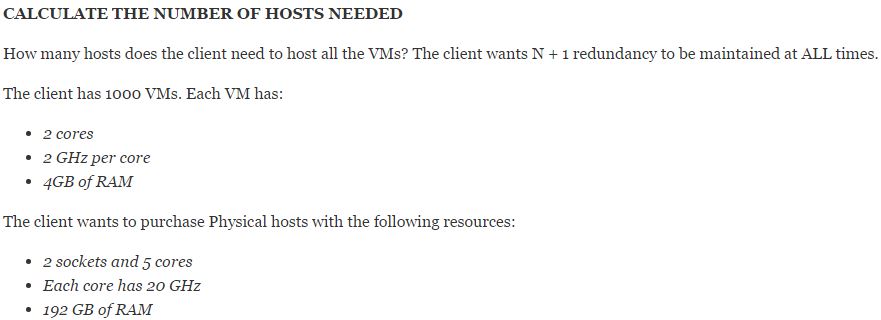The reason why most people are unable to solve this question is because of what is assumed and hasn’t been explicitely mentioned: overhead. I always treat overhead as a mandatory input: Workloads should be able to run without contention and there should be enough free resources to run ESXi and its tasks at all times.
Unfortunately a lot of people who try to solve this question do not consider overhead because the question does not specifically mention overhead. But to me, overhead is good practice and should be mandatory even when it is not mentioned. So in the exercises in our VCAP-DCV DESIGN simulator I have taken 20% overhead for ESXi. This value has been based on an officially endorsed good practice out of the following book: “Managing and Optimizing VMware vSphere Deployments – by Crookston & and Stagner“, an official VMware book, and which uses 20% as a general overhead value. See pages 6 and 7.).
One could of course say that if one can assume overhead, one should be allowed to assume workload contention as well. The way I like to see this is that overhead will never negatively impact workload performance where as contention will always impact workload performance. Hence, adding overhead is a good practice, immediately considering solutions such as ‘shares’ to decrease the performance impact on critical apps and medium apps is not unless an SLA has been defined for specific workload tiers.
This question contains another assumed hint: there are no costs mentioned, so why assume that contention should be ok?!
Obviously
The way overhead is treated in official VMware documentation (or any other vendor) is not always very clear either. Sometimes VMware adds overhead values to calculations, sometimes it does not. I can understand that most vendors (not just VMware) do not like to add overhead values because the exact overhead values can and will vary from environment to environment. For example, in some cases VSAN will need about 10 % to run itself, where as in other cases VSAN will need close to 30%. [Should you open the VSAN design guides, and would have a look at the calculations , if my memory doesn’t play tricks on me, you would quickly discover that these guides do not consider overhead for ESXi in any of the calculations and only add a minimal overhead for VSAN. Of course you know that the more features you enable in VSAN, the more resources it will use to run itself and of course you have also noticed that none of these calculations add overhead to run ESXi. Room for some thought.]. So not adding overhead in documentation makes sense because not all environments require the same amount of overhead to run a solution.
Conclusion
For the exersizes in the sim I have used 20% as overhead and should this annoy some of you, I apologise. The question which remains now is: should you use overhead in your calculations for the VCAP-DCV Design exam? Well, I always do add it and Bilal never does, unless the overhead is specifically mentioned. But we have both passed our design exams.
Some years ago when I took a vSphere 5.5 Design class we asked the instructor what value we have to use for overhead in the exam, even when it is not specifically mentioned in the question. He told us that any value which makes sense probably would be ok. This is a very shady answer and really does not help any of the students. In fact it does the opposite: It confuses students even more! This is the biggest problem with the calculation exersizes in the VCAP-DCV Design exam: If Education is unable to tell us, how are we supposed to know?
I think it would be better if people who will write the design exam would know what to expect and get better guidance in these type of exercises. Instructors should be able to tell the participants if overhead should be added to the calculations in the exam. People shouldn’t have to guess this.
But for real life scenarios, does one always have to consider overhead? The answer is very short: Yes.
The post VCAP6-DESIGN compute calculation appeared first on .
The original article was posted on: vmusketeers.com





